Reed Canyon Enhancement Strategy
Non-Native Species Management
Non-native species control in the Reed Canyon will require the use of an adaptive management strategy. Past impacts and surrounding landscaping have favored the dominance of invasive non-native species. Long-term management of these non-native plants will be necessary to restrict their spread into new areas and to reduce the existing populations. Revegetating areas with native plants will help to keep the invasive species from recolonizing bare areas.
By monitoring the success of each technique applied, Reed College staff will be able to scientifically assess when, where, why, and how additional efforts will be applied and managed. Maintenance of newly cleared or planted areas will also be necessary to ensure eradication and revegetation success.
The current site conditions (size, slope steepness, water quality conditions) dictate that an aggressive hand and mechanical removal program, combined with limited herbicide applications should be tried first. In the lake, mechanical removal of invasives will save time and energy. The steep bank areas with overstory will require the use of hand labor, by both professional and community stewards. Again, the key to success will be regular monitoring and maintenance of site conditions to ensure efforts will not be quickly undone by the undesirable species. The use of fire, solarization, biological controls and more intensive herbicide treatments are management measures of last resort for this site.
This section details information on the preferred management strategy for the different non-native invasive species found on site. The implementation strategy, in terms of timing of removal, access, permitting, site considerations, and costs, are provided in the Implementation Strategy section.
Both short and long term control measures should prioritize the following target species:
- Himalayan blackberry
- English ivy
- English hawthorn
- Clematis (travelers joy)
- Nightshade
- Morning glory
- Reed Canarygrass
- Teasel / Thistle
Access for removal activities would include 37th Ave at the east end of the site and the pathways and maintenance access near the maintenance operations building. Management recommendations for the removal of specific non-native species from the Reed Canyon site are outlined below.
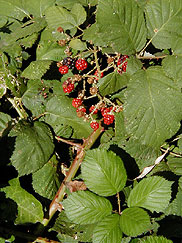 Himalayan blackberry (Rubus discolor)
Himalayan blackberry (Rubus discolor)
An introduced Eurasian species, this weak-stemmed shrub often climbs over other vegetation, eventually crushing or smothering weaker species and forming formidable thickets. Along streams, the weight of the plant also causes erosion by pulling the bank down. Leaves are palmately compound, generally with five toothed leaflets. Sharp, flattened thorns are present on the leaves as well as stems. Flowers are white to pale pink, approximately an inch across, and bloom throughout the season. Berries are edible and tasty for humans, but few native birds / mammals forage the berries, diminishing its habitat value. The shrub reproduces both vegetatively by sending out runners and rhizomes, and by seed.
Reed Canyon and adjacent properties support extensive stands of Himalayan blackberry, which typically colonizes disturbed areas. They have formed patches in hummocks (low gradient islands) surrounded by water, and in drier portions of the site. Their canes and prolific berry production will continue to spread the plant throughout the site where conditions are favorable.
Recommended Management Strategy:- Physically remove large accessible plant masses (root and stock) with mechanized equipment in the summer, prior to berry production. Inaccessible areas and blackberry close to native plants can have canes removed anytime (early summer is most convenient).
- Hand remove remaining stocks and roots in late winter. Repeat hand removal of new shoots in spring and late fall (after rains) annually. Properly dispose off site or burn dried canes on site. Roots must be removed from site.
- Spot application of herbicide to remaining stocks to kill root over the winter (only in areas away from water and native vegetation). Rodeo or Vantage with a surfactant is recommended. Follow manufacturer's recommendation regarding application rate. Hand remove new shoots and roots in spring and fall.
- Overseed cleared areas with sterile wheat or "Re-Green" to help reduce erosion of disturbed soil. Continue shoot removal until density is reduced to one shoot per 5 sq feet, or less.
- Conduct annual monitoring and maintenance in early spring, summer and fall; hand pull new shoots and remove from site.
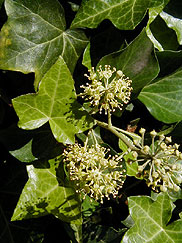 English ivy (Hedera helix)
English ivy (Hedera helix)
English ivy is an evergreen woody vine with thick, typically lobed leaves. Mature plants will eventually produce round clusters of small greenish flowers followed by black berries. The vines can cling to nearly any vertical surface using aerial rootlets that extend out from the stems. The plant's rapid growth upward into trees can ultimately shade the supporting tree to the extent that photosynthesis is affected, resulting in hampered growth. In addition, the increasing weight of the vines can eventually topple a tree that has been otherwise weakened by stresses such as root rot. The roots of the ivy tap into the cambium layer of some trees, depriving them of water and ultimately killing the tree. This characteristic makes it difficult to remove as the rooting can occur many feet above the ground surface.
This non-native vine has spread throughout the site over time, probably introduced as site landscaping or by berries from nearby residential landscaping. The ivy has developed into the dominant ground cover in most upland places and is infesting numerous trees as well.
Recommended Management Strategy:- Physically hand remove ivy from the ground and trees by cutting and pulling when the soil is soft enough to pull roots up. Carefully pull the roots and try to minimize breakage, otherwise the remaining root can re-sprout. Large vines that have climbed up in trees should be cut at the base and pulled from the tree once the ivy has died. If vines have rooted into the tree, use a ladder to climb the tree and break free the vine. If conducted during the winter, the vine can be pulled immediately without damaging the tree. Properly dispose of vines off-site or burn dried vines and roots on site.
- Overseed cleared areas with sterile wheat or "Re-Green" to help reduce erosion. Rake disturbed areas smooth before re-seeding. Continue vine removal until density is reduced to one shoot per 5 sq feet or less.
- If necessary, a broadcast spray of herbicide may be applied after the leaves have been string line trimmed and raked out, but only in areas where there are no native species. Breaking the leaf edges allows for a better application of herbicide. Spot apply until eradication is complete. Herbicide is not effective on leaves that have not been cut opened. It is best used to kill the roots and new shoots.
- Conduct annual monitoring and maintenance in early spring; hand pull new sprouts.
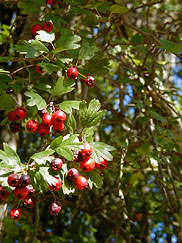 English Hawthorn (Crataegus monogyna)
English Hawthorn (Crataegus monogyna)
English hawthorn is a small deciduous tree that has 1.5" deeply lobed leaves that resemble tiny oak leaves, and thorns on its bark. It produces an abundance of red berries in the late summer that the birds help to transport. It can form dense thickets and out compete other small native trees. The native black hawthorn has similar form, but its leaves are oblanceolate with serrated edges rather than lobed.
There are several scattered locations at Reed Canyon where this species is found. Removing it from the site now will help prevent problems with their management in the future.
Recommended Management Strategy:- Hand remove by clipping the stock to 6". Grub out the roots or treat the remaining stock with a brush on herbicide to kill the roots. Properly dispose of plant off-site or burn stocks on-site.
- Hand pull any new growth in treated areas when found in spring. Do not allow plant to seed.
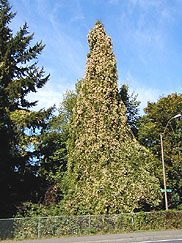 Clematis, Traveler's joy (Clematis vitalba)
Clematis, Traveler's joy (Clematis vitalba)
Clematis is a woody, deciduous, semi-shade tolerant perennial vine. It is particularly common in disturbed open canopy areas of riparian and deciduous woodlands. Its rapid growth (up to 20 feet per year) tends to smother the ground and the plants it has attached itself to. When the vine extends up into trees and shrubs, it produces an abundance of wispy flowers that eventually seed and spread the plant downwind. The heavy weight of the vines eventually damage or fall the trees and shrubs from which it hangs.
Clematis in the Canyon is found throughout, but is heavily concentrated in the upper lake and on the northern slopes, within the trees. The plant is also on adjacent landowner trees.
Recommended Management Strategy:- Initial efforts should focus on removal of mature flowering vines from the trees. Plants should be cut close to the ground, and removed once the tree has gone into dormancy for the winter. Roots of the vine around the trees should also be pulled when the soil is moist and properly disposed of off-site or burned on-site. The use of herbicide should be avoided due to potential damage to the native trees and shrubs with the use of herbicide.
- Hand pull any new shoots and remove from site.
- Work with neighbors to remove plants from trees bordering the Reed Canyon property.
Nightshade (Solanum sp.) / Morning Glory (Ipomoea sp.)
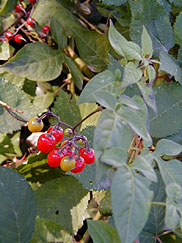
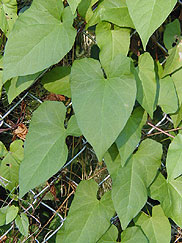
Nightshade and morning glory occupy similar environments and are similar in form. They are rhizomatous perennial non-natives with a persistent woody base. Introduced from Asia and Europe respectively, these plants prefer the moist habitat along the edges of wetlands, ditches and riparian corridors (morning glory likes it slightly drier). Nightshade has dark green heart-shaped leaves that often have one to several leaflets at the base. It has a star-shaped purple flower with a yellow center that is followed by a bright red berry that contains abundant tiny seeds. Morning glory has lighter heart-shaped leaves and a large white tulip-like flower.
Both these species are found in abundance throughout the upper lake area both in the wetland areas and upland fringes.
Recommended Management Strategy:- Repeated cutting via flail mowing or string line trimming followed by raking of remaining plant material is recommended. Debris should be picked up and burned or otherwise disposed of off-site, since stems easily propagate from cuttings. Cutting should be carried out before the plants flower to reduce the spread of seed.
- Grubbing of the roots by hand is difficult due to the rhizomes nature, so mechanical (backhoe) removal of the soil, where possible should be attempted. Solarization of the ground around the infestation should be attempted where mechanical removal of the root mass is not possible.
- Herbicide treatment is not recommended for these plants due to the close proximity of their roots to native trees and shrubs, and water. The herbicide may be translocated to the native plants or impact water quality.
- Hand pull any new shoots and remove from site.
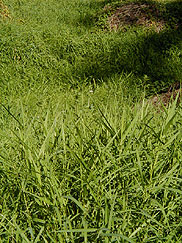 Reed Canarygrass (Phalaris arundinacea)
Reed Canarygrass (Phalaris arundinacea)
Reed canarygrass forms a dense mat of grass that can tower as high as 7 feet high in both wetland and moist upland areas. This perennial grass spreads by rhizomes as well as by seed. This grass is common throughout the upper reaches of Reed Lake, but has yet to spread to the lower lake and crystal springs canyon. It is believed that the reed canarygrass requires the formation of islands of sediment to successfully establish in open water environments. The clear waters of Crystal Springs carry very little sediment, making the formation of sediment hummocks in the middle and lower reaches of the lake slower than expected.
Reed canarygrass is dominant in the aquatic portion of the upper lake and in limited areas on the fringes of the lower lake.
Recommended Management Strategy:
- Small patches may be controlled by string trimming in the early spring prior to the plant setting seed. As the plant is weakened, it may be dug out of the ground.
- Large infestations require mechanical removal in order to remove the mat. For this site, it would be best to conduct the aquatic component in the winter with the use of an aquatic weed harvester. The level of the water would need to be elevated to approximately 3' depth to use such equipment, but it offers a promising result with limited impact to water quality or the bottom sediments of the Lake. The removal may need to be repeated to significantly reduce the infestation. The edge areas would need a small backhoe and should be removed in the summer. The stocks should be string trimmed to eliminate the seed head production, prior to the mat removal later in the summer.
- Spot application of herbicides may be done in non-wetland areas during the summer months. Rodeo and vantage are recommended in the non-wetland areas at the manufacturer's recommended application rate. In wetland areas, new shoots should be dug out and removed from site.
- The reed canarygrass mat should be hauled up to a dewatering area, and then properly disposed of off-site.
Teasel (Dipsacus fullonum)/ Thistle (Cirsium sp., Carduus sp.)
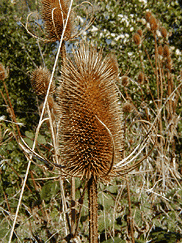
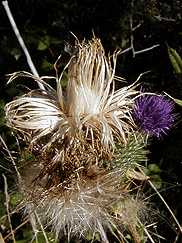
Teasel and thistle are rapid spreading colony forming herbaceous weeds that use wind and pollinators to spread their seeds. Teasel has a 4-6' tall armored stalk with a cone-like purple flower and seed head that turns brown in late summer and is persistent throughout the winter. Thistle is 2-3' tall with needle-like armor and a seed/flower head that looks like a purple upside down cap. Both species are limited on site, but should be controlled early to avoid greater levels of infestation. They quickly invade disturbed soil and prefer drier conditions. Recommended Management Strategy:
- String trim stalks in early summer when the plants are in between flower bud and seed stage. Carefully remove stalks and burn or dispose off-site.
- Apply wick application of herbicide to the remaining rosette.